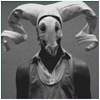Sign In
CloseDead-end Art by EdoEbontongue
Some genres of art, like branching stems of evolution lead to new forms of art. Impressionism leads to Fauvism. Dadaism leads to Surrealism. Its interesting where clearly certains styles of art peak, and it cannot be explored anymore. An artistic dead-end, when all that style had to say was said.
There is Baroque leading to Rococo.
There is Impressionism leading to Futurism.
Honestly I'm not really a fan of either. Rococo has so much intentional charm crammed into it its as though its puking wonder and awe. Futurism was made by a bunch of presumed a-holes. Boccioni and Severini, I'm sorry but I don't quite like you guys for some reason, maybe its the whole obsession with youth and violence. I'm sure your live preformances rivaled that of Duchamp but nasty attitude about it.
But those were mere blips in the course of time. Some just reached dead-ends because they had been done to death over the course of centuries, such as Byzantine triptychs. Though not used as much, I am a fan of the Baroque stylistic techniques of Tenebroso and Chiaroscuro.
Thoughts.
Journal Information
- Views:
- 180
- Comments:
- 4
- Favorites:
- 1
- Rating:
- General
Comments
-
-

I am pretty uninformed on movements as well. I had an art history course that covered art from the prehistoric era until... possibly middle ages I can't remember now. That was like 7 years ago likely. I am very rusty. Also took one or two phil courses on aesthetics. Whatever I have learned has disconnected itself from the source material and the meaning I took from all that stuff is internalized. I feel like I aught to know more/would enjoy learning about art movements but I feel that way at about literally every body of knowledge I encounter.
-
-

I want to take the analogy to evolutionary biology further as we can some fun with this. In a very concise summary, things evolve to adapt to changes in it's environment. As per the saying "Art doesn't exist in a vacuum" there are reasons why certain styles fell out of favour or others blossomed over that of their contemporaries, some styles or movements unlike the biological classification can be seen under not just one taxonomic system but several. Some styles were only given a name long after they've ended, while others had a larger ramification than just something that occurred in the art world; a large cultural trend ofter termed the 'zeitgeist'.
Impressionism didn't just lead to Fauvism, it forked off into Expressionism, Cubism and Privitivism. Once Art hit the 20th Century it became a far more messier affair. Surrealism didn't just lead off into Dada, they coincided for the majority of their most active peaks and shared a lot of the same artists that overlapped. Both Dada and Surrealism arose due to the profound tragedy of two world wars and how Europe was divided, that was completely fresh in everyone's minds as artists also fought in the trenches. Salvador Dali was influenced by the Spanish Civil War, John Paul Nash was the War Artist for the British Defence Ministry, Walter Gropius fled Germany in 1930 once Bauhaus was closed down and became a figure in American Architecture. All the artists I've looked into that moved on from their past involvements was to find a new vocabulary to express their new feelings and sentiments by the events in their lives.
The maps, time-lines, graphs and taxonomies we make and craft is just to summarize the miniscule details of a vast amount of living animals that adapt and change. Once it the style comes to it's end, I think a better analogy that might drive my point home; is if you were to keep a journal, and just document a month. A single month. There is only so much you can do and think about in a month, of set days, hours, minutes and seconds. That month would be your movement. Whether you produce forty pages or forty thousand we could summarize your life experiences; "Oh, and this is my February period!". If a photograph was worth a thousand words, I'm less interested in not that there is an end supply of photographs but more into what it is they said.
Just for my own reference in case I forget, the different ways I know how movements can be classified are;
By 'Type'; Applied or Pure Art. That is Jewellery, Fashion, any designed object that was made for utility such as ceramics, to paintings, print making. (The boundary gets confusing with Art Nouveau, which had so few painters because they didn't make paintings, they made posters, which they as their ethos believed art should be more practical.)
By 'Convention'; Basically Technique, if there's been a breakthrough with a new medium a lot of artists that attempt using it will be more known by working with it than by any set style. e.g. Illusionism with Trompe-L'œil and Anamorphosis, and a variety of groupings prior to Naturalism with the use of Tempera. So art here was to reach technical limits and to see what could be done.
Regarding these two categories, I think by Convention helps explain the changes in Architecture over time. We no longer build pyramids, or Byzantine designs because our understanding of design and engineering became more sophisticated, and we had access to more material and equipment. Art Nouveau really took advantage of this for jewllery, Art Deco did the same for architecture. As well as the Byzantine Empire fell with the fall of Constantinople and Egypt doesn't have political structure or religious life it did four thousand years ago.
Other groupings that were predominantly responses to the artwork was:
By 'declaration'; During the 20th century a lot of people wrote manifestos on their vision for a movement even when other artists already wrote manifestos for the same movement. Futurists are also assholes as you said, they'd be the kind of people who would unironically wear a 'nuke the whales' sticker. I'm something like 99% sure Futurism rose out of Italian Fascism.
By 'Public Ridicule'; I love Mannerism but it was initially called mannerism as a way to disparage it's break from the more dominant conventions and motifs, so a lot of diverse artists got their work called mannerist which how they got unified together in the art history textbooks is because people didn't like their work for the same reasons.
By 'That Spirit of the Times'; Romanticism is the flagship example, this wasn't just an art trend, this affected literature, philosophy, theology, education, and people's entire outlooks. It also clashed with the Enlightenment. It was New Age before New Age was a thing, nature was an intimate connection that should be show respect, child should have their curiosity and wonder unspoiled by bookish learning. So Art just got dragged in for a ride because of the culture the artists were in at the time (ie. anywhere in Europe.)



Link
duskysam
I took one Art History class in college and did only fairly in it. I pick up art sporadically via tumblr/internet and the ever so occasional foray to a museum or art gallery. I fall back upon the ignorant "I know what I like" statement, which to me does hold some legitimacy, which means I am really uninformed. I make my own art at times and feel I can go much farther with it, but that is another story.